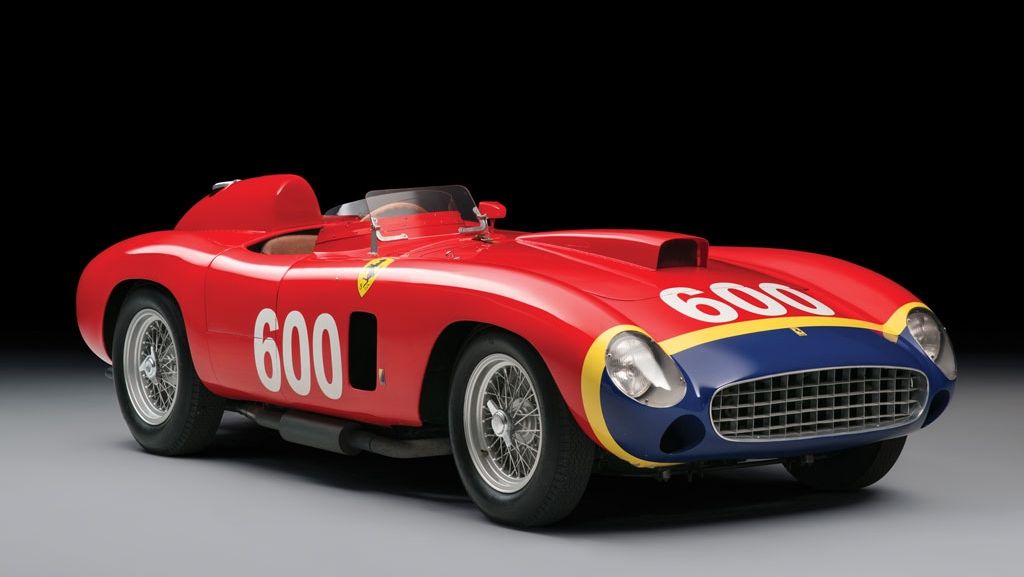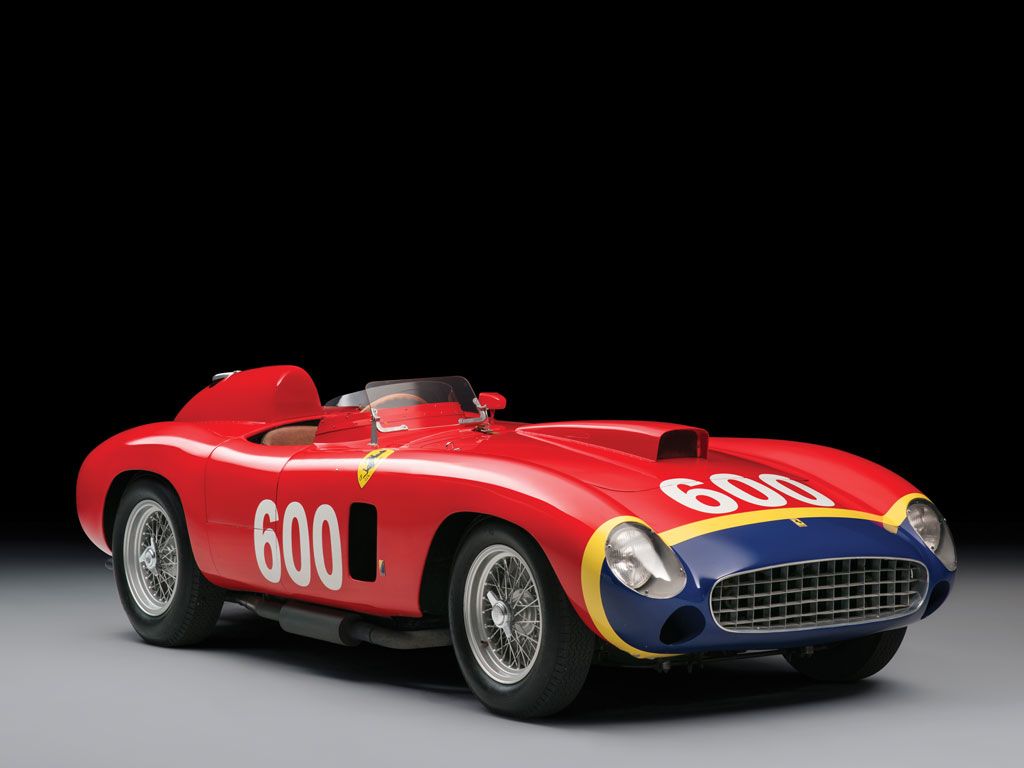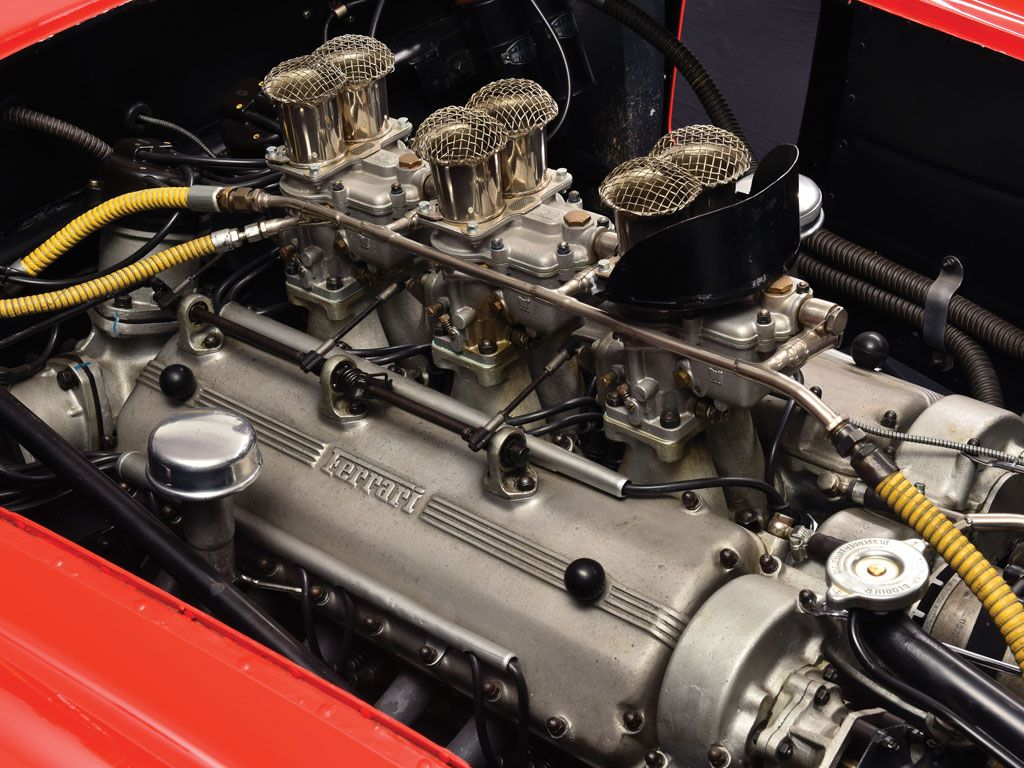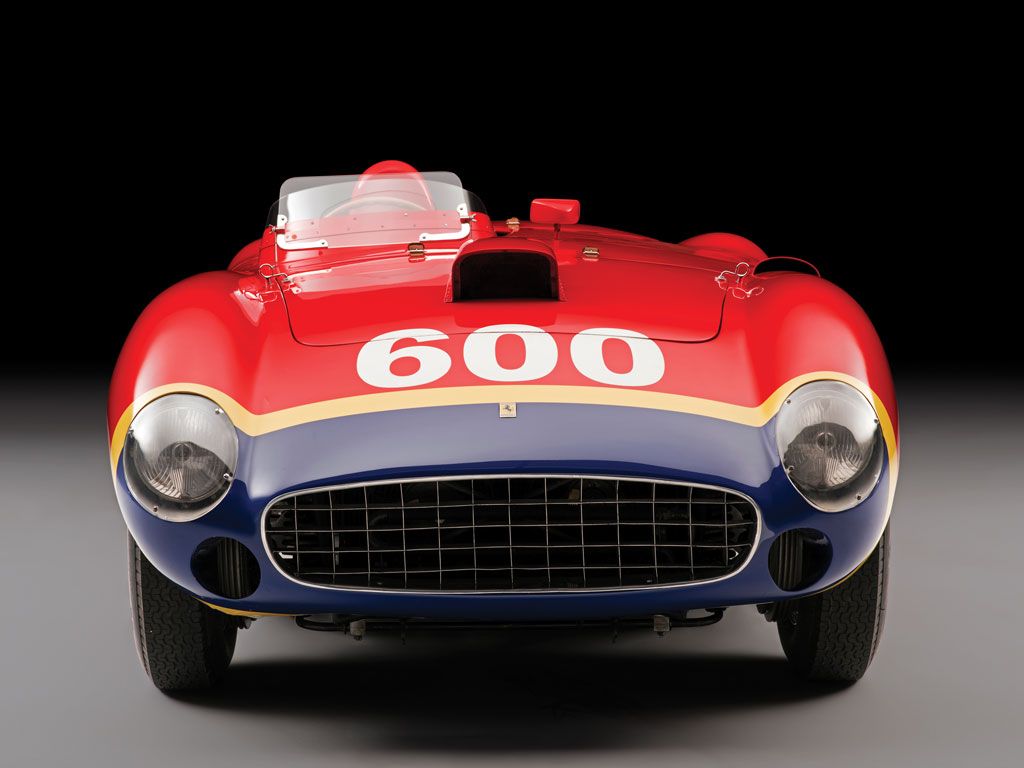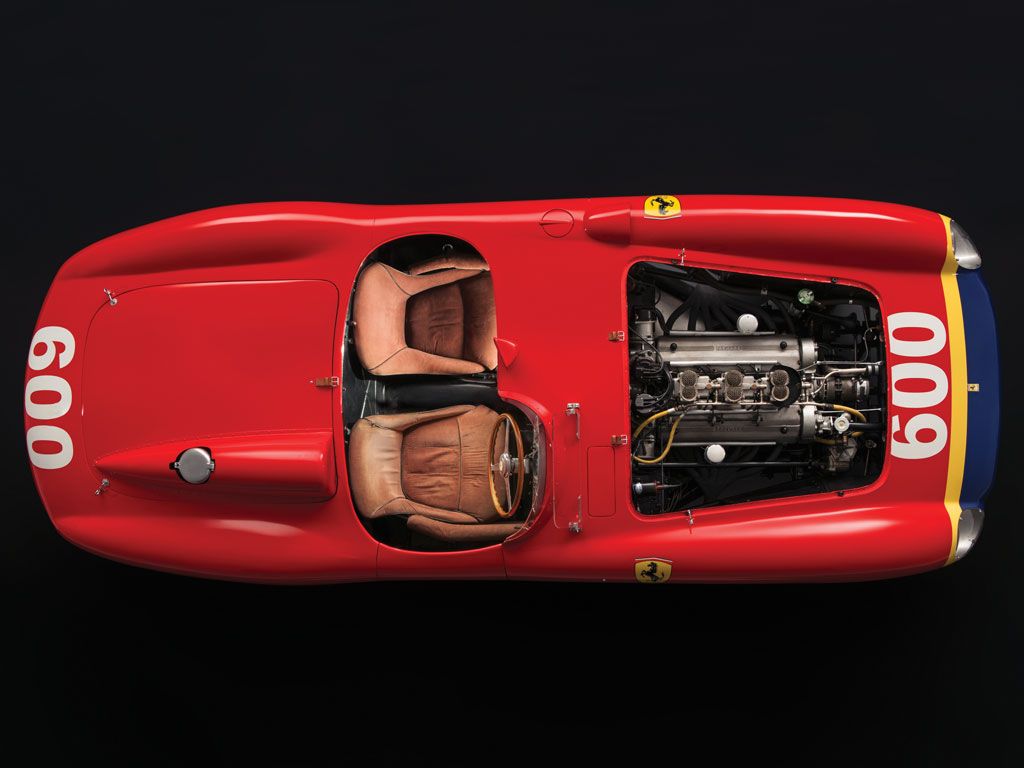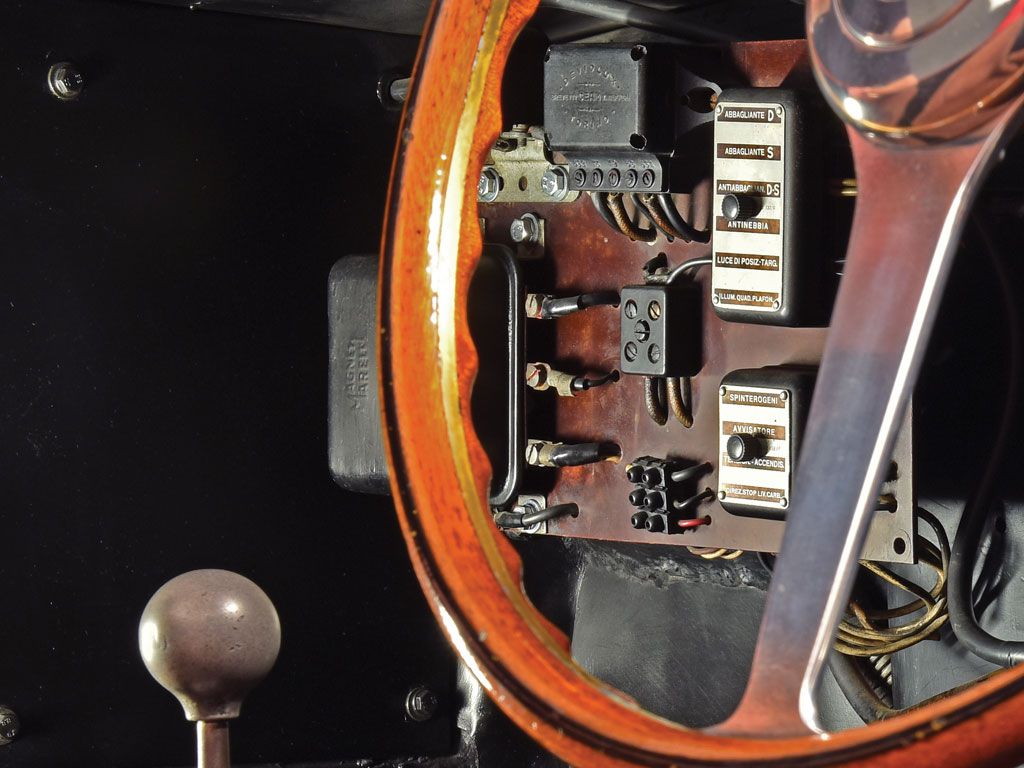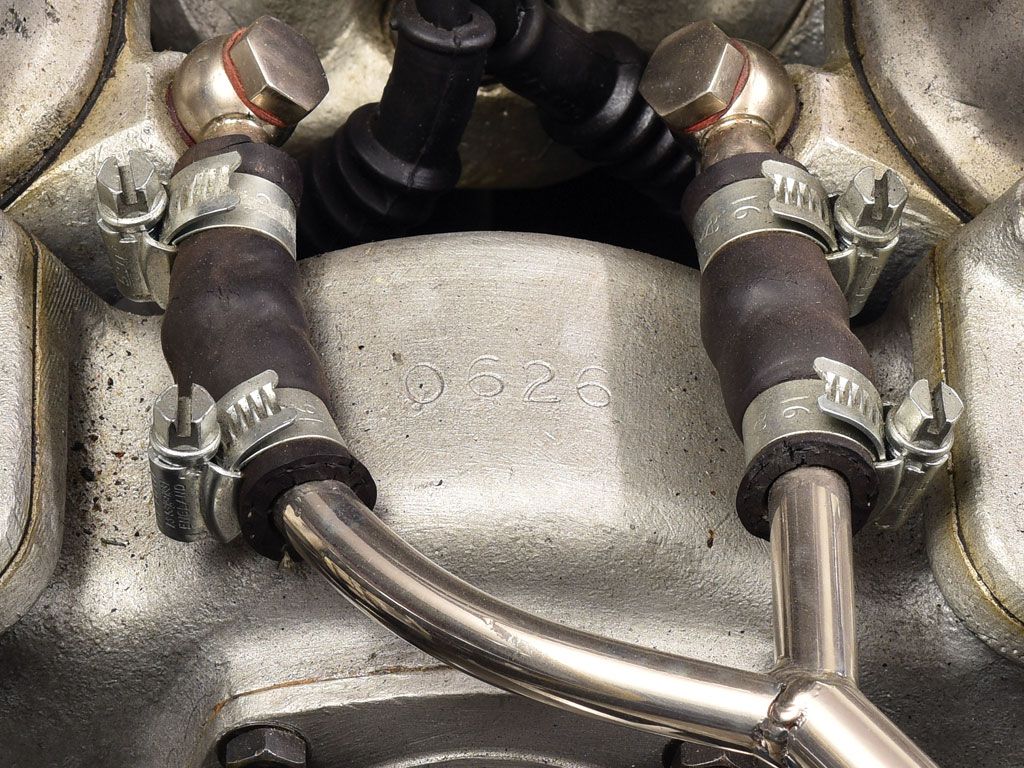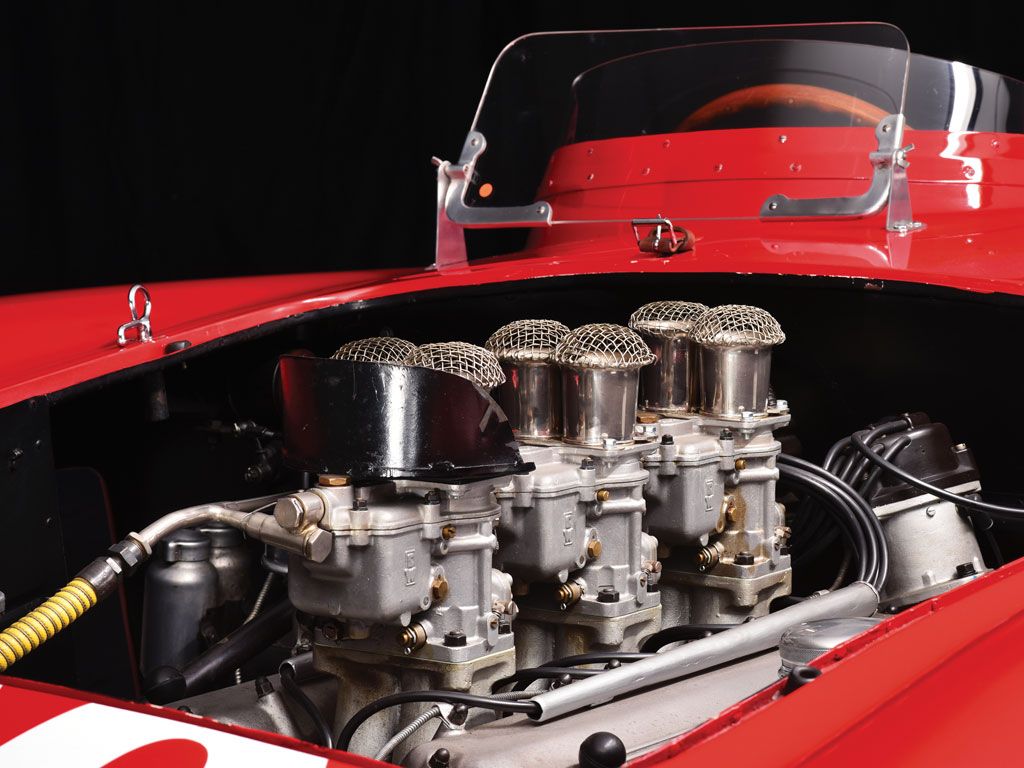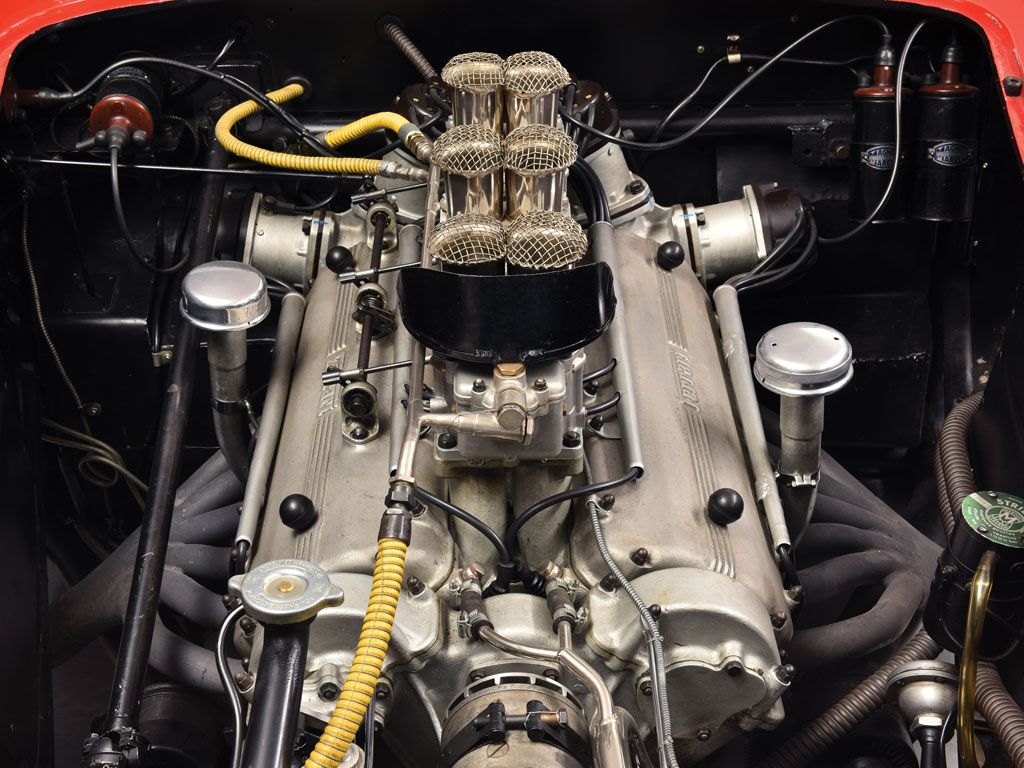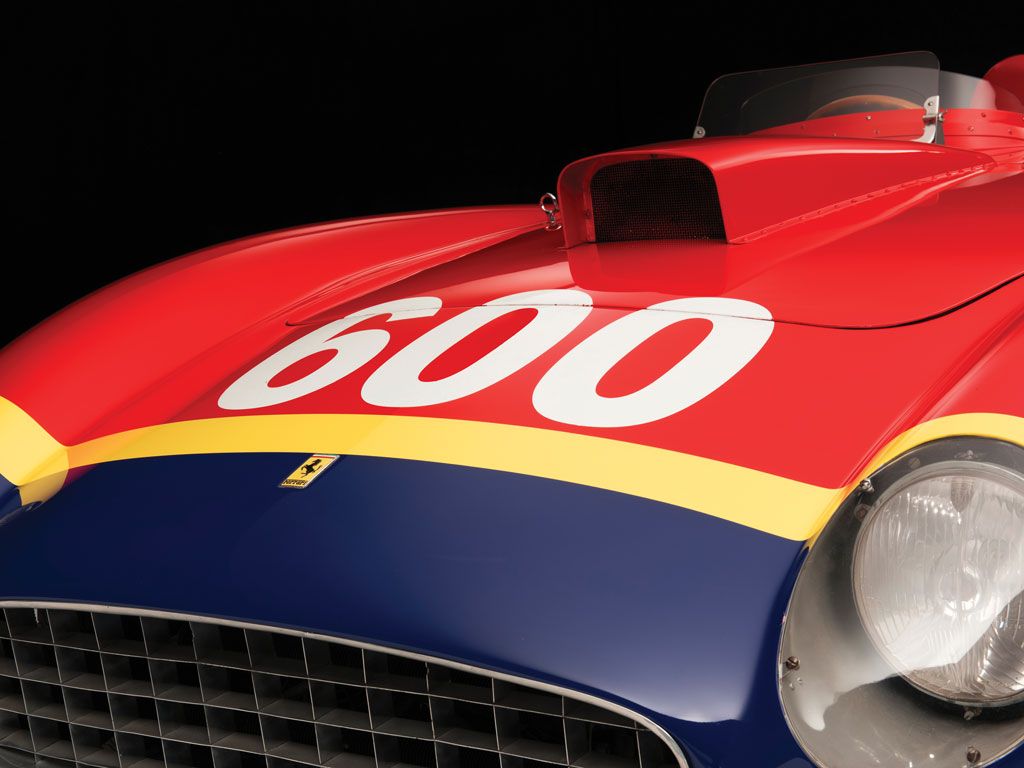As the FIA was preparing to gather the most important sports car, endurance, and road racing events in Europe and North America under the World Sportscar Championship banner, Ferrari->ke252 shifted from using the Colombo-design V-12 engine in its smaller racers to a new family of four-cylinder units Aurelio Lampredi developed for Formula One.->ke190 Thus the Ferrari Monza series was born, which included models such as the 625 TF, 500 TR,->ke3243 and the 860 Monza.
With the larger 340 MM, 375 MM, and 375 Plus backed by the Monzas, Ferrari was able to sweep the first two runnings of the World Sportscar Championship against competition from Jaguar,->ke39 Aston Martin,->ke13 and Lancia.->ke45 Things changed, however, in 1955, when Mercedes-Benz->ke187 introduced the 300 SLR -- the race car that went on to win the championship in its maiden season. Having won only one race in 1955, Ferrari commissioned Vitorio Jano to develop a new V-12 engine for the lightweight 860 Monza. Maranello replaced the four-banger with a 3.5-liter V-12 and the car was renamed the 290 MM.
Raced alongside other Ferraris, the 290 MM helped the Scuderia win the World Sportscar Championship in both 1956 and 1957 before being replaced by the infamous 250 Testa Rossa.
Often overshadowed by the fact that it was built in a transition period for Maranello, the 290 MM is arguably one of the most important Ferraris of the mid-1950s, especially for enabling the Italians to win against iconic race cars->ke148 such as the Maserati 300S->ke1219 and Jaguar D-Type.->ke1250
Updated 12/11/2015: A very unique 1956 Ferrari driven by Formula 1 world champion Juan Manuel Fangio was sold at RM Sotheby's Drive by Disruption sale in New York on December 10th, 2015.
Continue reading to learn more about the Ferrari 290 MM by Scaglietti.
1956 Ferrari 290 MM
- Make: Array
- Model: 1956 Ferrari 290 MM
- Engine/Motor: V12
- Horsepower: 320 @ 7200
- [do not use] Vehicle Model: Array
Exterior
Based on the Scaglieti-designed 860 Monza, introduced in 1956, the 290 MM was nearly identical to its predecessor. The 860 Monza itself was an evolution of the 1953 625 TF and had a design that would continue to be used until the late 1950s. In many ways, the 290 MM was a less aggressive and simpler version of the 250 Testa Rossa.
While the 860 Monza and the 290 MM were identical as far as shape and size went, the latter received minor changes alongside its new V-12 powerplant. The front fascia gained larger vents underneath the headlamps, while the hood featured a significantly bigger scoop. The windscreen was reduced for improved aerodynamics. The revised exhaust pipes were now visible underneath the side skirts.
As with many 1950s Ferraris, some exterior features, such as hood scoops, fog lamps, windscreens, and mirrors varied from one race to another, but the overall shape and size of the car remained unchanged until its retirement in the 1960s.
The model shown here, chassis number 0626, was restored in the exact same livery of its maiden race, the 1956 Mille Miglia. Wearing no. 600 and a blue-and-yellow nose, this 290 MM was driven by legendary F1 driver Juan Manual Fangio to a fourth place finish at the end of a grueling race that saw only half of the 365-car grid reach the finish line. Fangio's result was that much more extraordinary given he started last and drove without a navigator through torrential rain.
Interior
The 290 MM had the typical 1950s Ferrari cockpit, which included a pair of leather-wrapped seats, a wood-rimmed steering wheel, an a tiny dashboard with various gauges, buttons and switches mounted on the driver's side. Though leather wasn't a common feature in 1950's race cars, the 290 MM was far from luxurious. The exposed floor panels, the simple pedals, and the spartan door panels were there to tell that this Ferrari was a full-fledged race car.
Drivetrain
The 290 MM was produced in a transition period for Ferrari, when the company was still using Colombo and Lampredi V-12 engines, but Vitorio Jano and Andrea Fraschetti had arrived from Lancia to work on a new design. But, because there wasn't enough time for a brand-new engine, Jano's proposition for the 290 MM was a 3.5-liter V-12 derived from the 4.5-liter unit which was then used in Ferrari's Formula One cars. It combined components of the earlier Lampredi and Columbo V-12s, a SOHC roller/rocker valvetrain, twin-spark ignition, and three Weber 40DCF carburetors.
The naturally aspirated engine was good for 320 horsepower at 7,300 and gave the incredibly light 290 MM, which tipped the scales at 1,940 pounds, a power-to-weight ratio of 364 horses per tonne. The oomph traveled to the rear wheels through a four-speed manual transmission with a limited-slip differential and pushed the Ferrari toward a top speed of 160 mph.
In 1957, the engine was updated into a 3.8-liter and fitted in the 315 S, and then increased to 4.0 liters and used in the 335 S. In its most powerful iteration, Jano's first V-12 developed close to 450 horses.
Drivetrain Specifications
|
Type |
front, longitudinal 60° V12 |
|
Bore/stroke |
73 x 69.5 mm |
|
Unitary displacement |
290.88 cc |
|
Total displacement |
3490.61 cc |
|
Compression ratio |
9 : 1 |
|
Maximum power |
320 HP @ 7,200 RPM |
|
Power per liter |
92 hp/l |
|
Top speed |
280 KM/H (173 MPH) |
Prices
Because Ferrari didn't sell the 290 MM to privateers, the original price of the race car is unknown. However, much like any classic Ferrari, the 290 MM has evolved into an incredibly expensive vehicle, with all examples estimated to fetch millions of dollars.
Arguably the most coveted of the four examples made, chassis 0626 is the most valuable, being sold for $28 million during RM Sotheby's Drive by Disruption sale in New York on December 10th, 2015. The $28-million sticker makes it the second most expensive Ferrari ever auctioned and the third most expensive car ever to go under the hammer as of December 2015, after a $38-million 1962 Ferrari GTO and a $30-million 1954 Mercedes-Benz W196 Formula One car. The 290 MM is also the most expensive vehicle auctioned in 2015.
The amount isn't surprising given the #0626 was never crashed during its career and spent 34 years in the Mas du Clos collection of Pierre Bardinon before being acquired by its current owner. For the past 12 years, the car has been regularly maintained, benefiting from a recent engine rebuild. Also, the previous owner has had the car Ferrari Classiche certified to further confirm its originality.
Racing History
The 290 MM made its racing debut in April 1956 at the Giro di Sicilia and won its first race only three weeks later at the Mille Miglia. The Ferrari then scored a third-place finish at the 1,000km of Nurburgring and a 1-2 at the Swedish Grand Prix, helping Ferrari win the World Sportscar Championship ahead of Maserati.
1957 was by far the 290 MM's busiest season, gathering 19 entries on both sides of the Atlantic. Although it won just one race in the World Sportscar Championship, at the 1,000km of Buenos Aires, the 290 MM helped Ferrari secure yet another manufacturers' title. The 290 MM entered both the 12 Hours of Sebring and the 24 Hours of Le Mans that year, but failed to finish. Towards the end of the year, it won the Nassau Trophy with Stirling Moss behind the wheel.
Though it continued to race until 1964, the 290 MM failed to win any races from 1958 onward. Among its final achievements were a second place-finish at the 1958 USAC race at Watkins Glen and a third-place finish at the 1959 Nassau Trophy. Its final appearance occurred at the 1964 USRRC event at Mid-Ohio.
In all, the 290 MM ran 35 official events, scoring five outright victories and one class win. Famous drivers included Juan Manuel Fangio, Phil Hill, Wolfgang von Trips, Stirling Moss, Jo Bonnier, and Eugenio Castellotti.
Competition
Maserati 300S/450S
Introduced in 1955, the Maserati 300S clashed with the Ferrari 290 MM in both the 1956 and 1957 seasons of the World Sportscar Championship. Though it featured a similar design with the Ferrari, the 300S used a 3.0-liter, straight-six engine based on the 250F Formula One car that brought Juan Manuel Fangio two drivers' championships. Though it was the 290 MM's most competitive rival, the 300S failed to win the World Sporstcar Championship for Maserati, which had to settle as runner up in both 1956 and 1957. In 1957, Maserati also used the 450S against the Ferrari, a slightly larger, V-8 powered race car. Between 1955 and 1965, the 300S and 450 scored 78 outright victories and 40 class wins between them.
Read more about the Maserati 300S and 450S here and here.
Jaguar D-Type
Built between 1954 and 1957, the Jaguar D-Type was one of the most prolific race cars of the 1950s, scoring no fewer than 162 outright wins in more than 1,000 events until its retirement in 1965. Unlike the 290 MM, the D-Type was also offered as a customer car, with Jaguar selling 53 examples to privateers in addition to building 18 factory team units. Powered by 3.4- and 3.8-liter inline-six engines, the British race car won three consecutive Le Mans races between 1955 and 1957. The D-Type, however, failed to win Jaguar the World Sportscar Championship during its factory-backed career.
Find out more about the Jaguar D-Type here.
Conclusion
Though its career was rather short-lived compared to the Maserati 300S and Jaguar D-Type and it failed to win the 24 Hours of Le Mans, the 290 MM played a key role in Ferrari's successful World Sportscar Championship campaign between 1953 and 1964 -- helping Maranello win two manufacturers' title against strong competition from Maserati and Jaguar. It also marked the brand's return to a full V-12-powered racing lineup and paved Maranello's way to the famous 250 Testa Rossa. The 290 MM is definitely a winner and the fact that it was driven by the likes of Juan Manuel Fangio and Stirling Moss is just the icing on the cake.

